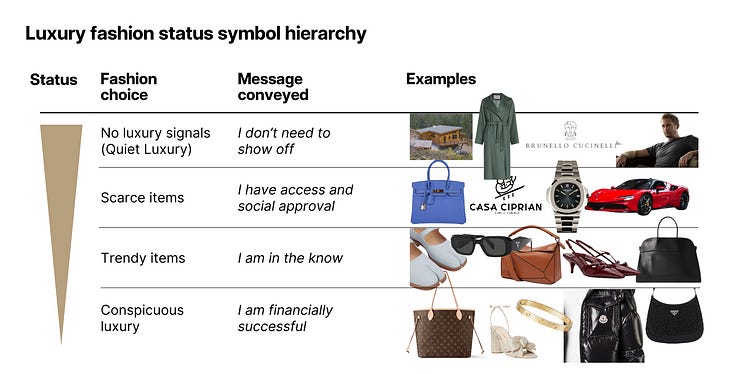What comes after quiet luxury?
Luxury fashion, status games, and how brands can innovate their status offerings
Luxury fashion brands serve as powerful social signals. I have the ability to acquire the impossible-to-buy Patek watch. Or the taste to spot and buy the latest it item.
But different fashion choices convey different signals. Conspicuous logos are outplayed by quiet luxury, which signals a level of success so strong, you no longer need to signal. Different circles also have different status codes. In HBO’s Succession, a woman is chastised for carrying a loud Burberry handbag to an event at a wealthy family’s home. Too gaudy. Too large.
“What’s even in there?…Flat shoes for the subway? Her lunch pail? It’s gargantuan. You could take it camping. You could slide it across the floor after a bank job.” — Tom Wambsgans, Succession
In Paul Graham’s essay, Cities and Ambition, Graham notes that status indicators differ by location:
What I like about Boston (or rather Cambridge) is that the message there is: you should be smarter. You really should get around to reading all those books you’ve been meaning to…As much as they respect brains in Silicon Valley, the message the Valley sends is: you should be more powerful. That’s not quite the same message New York sends. Power matters in New York too of course, but New York is pretty impressed by a billion dollars even if you merely inherited it.
Luxury products allow customers to choose the status they want to convey, from financial success (in some ways, the easiest to attain) to nuanced symbols of social approval and taste.
The fashion status hierarchy seems somewhat logical until you hear about the trend of über wealthy people sporting fake luxury products. What’s the signal there?
My parents have a good friend, who I will name Nicole, who owns multiple beachfront homes and regularly flies private. She chooses to buy fake handbags. Lots of them. When I visit Nicole will ask me what bag I want.
“Send me a photo of a bag— my guy will get you the exact one.” — Nicole
The Cut published article about this, titled, ‘The Rich New York Women who Love Their Fake Birkins,” detailing a web of networks used ship and sell the bags in modern day Tupperware parties. Supply chain of illicit handbags aside, something is happening here. Having a good fake is a new kind of status, one that beats having the real thing.

Having a good fake is a new kind of status, one that beats having the real thing.
With Nicole, being able to find quality dupes is the flex. It’s a bit illegal. You have to “have a guy.” Anyone (with money) can roll up to the store and buy Chanel. Finding a good fake means you’re smarter and better connected.
“If you have money, getting the most expensive trendy item… anyone can do that. But to find something that isn’t that but is still quality… feels like it takes effort and taste.” -Friend of author
But there’s something else beneath this. The existence of “good“ fakes suggests that the fantasy of luxury is cracking. Hermès backs up its prices with a rigorous creation process that takes the craftsman up to 40 hours to complete. But if a dupe is just as good… what happens to the aura around Hermès?
High prices are no longer a feature
Last month, the Wall Street Journal ran an article about luxury shoppers who have had enough of luxury price increases:
Heiji Choy Black, 46, grew disillusioned with luxury items earlier this year. A $4,000 dress she had coveted online felt flimsy…Black’s mood darkened further after she realized that, among luxury brands, even “basic” denim was retailing for over $1,000. “The bud was off the rose,” she said. — WSJ
I found this distain for ever increasing luxury prices in my own conversations, even among friends who have access to these products:
These bags are so overpriced, the Chanel 2.55 classic used to cost $1,200 in 2006, 2007… now it’s over $10K. Same bag. They can do it because they can do it. [The] designers are taking the piss… — Friend of author
In luxury, price used to be a feature. A badge showing that you can buy something others cannot. But no one wants to feel taken advantage of. Quiet luxury is a way to abstain from needing to signal your ability to pay high prices. But you’re still paying. On the contrary, fancy dupes are a way to fight back. It’s not paying luxury at all, and still getting the benefits.
If savvy and entrepreneurialism are new markers of status, dupes are how you show it.




